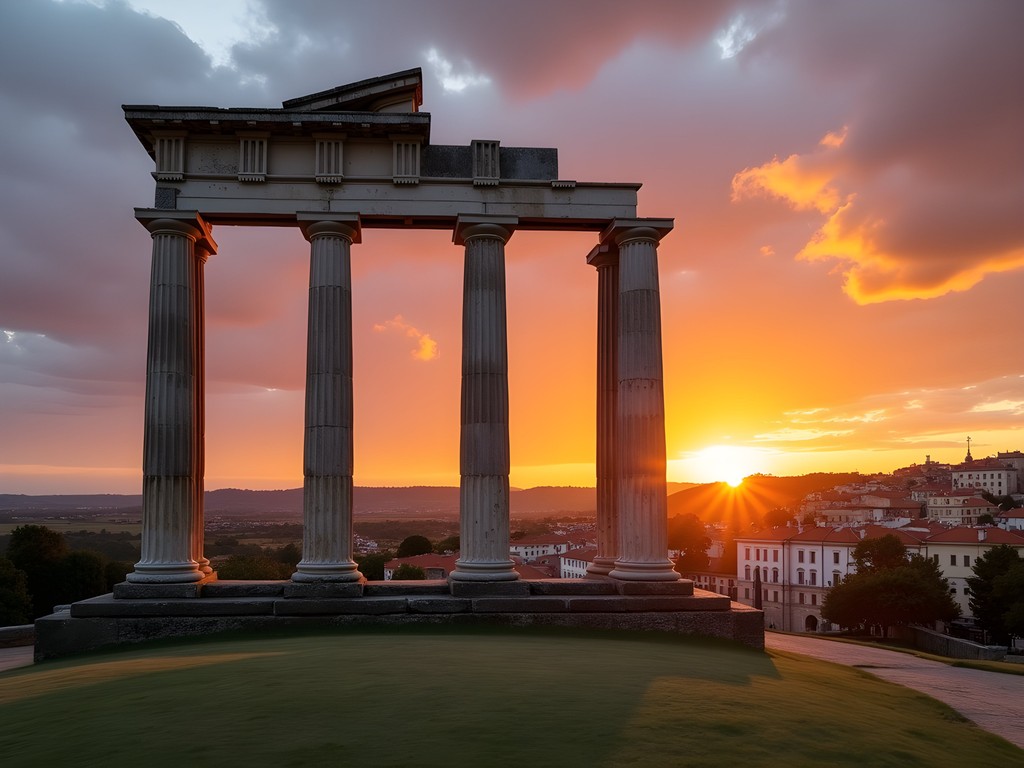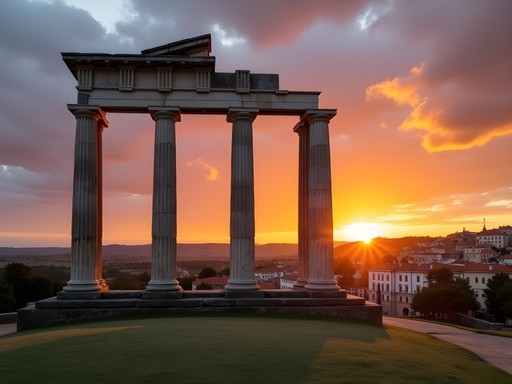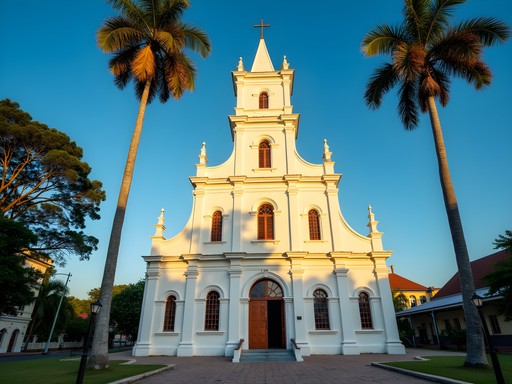Disclosure: This article contains affiliate links. We may earn a commission from purchases at no extra cost to you, which helps our travel content.
I'll never forget the moment I first stepped through Evora's medieval walls, the golden Portuguese sunlight illuminating 2,000 years of history before my eyes. This UNESCO World Heritage city might be compact enough to explore on foot, but it packs more historical treasures per square meter than nearly anywhere I've visited in Europe. After volunteering on a sustainable agriculture project in Portugal's Alentejo region last spring, I carved out a budget-friendly weekend to explore this ancient city that seamlessly blends Roman engineering, Moorish influence, and medieval Christian architecture. What I discovered was a place where history isn't just preserved behind museum glass—it's alive in the narrow cobblestone streets, the daily rituals at centuries-old cafés, and the stories told by locals whose families have called Evora home for generations. Ready to discover how to experience this historical gem sustainably without breaking the bank? Let me guide you through my perfect 3-day Evora adventure.
Day 1: Roman Remnants & First Impressions
My bus from Lisbon pulled into Evora's small station just before noon, and I immediately felt the difference from Portugal's bustling capital. The air was warmer, drier, and somehow seemed to carry whispers of ancient stories as I walked the 15 minutes to the walled city center.
I'd booked a small guesthouse within the medieval walls—a strategic choice that saved both money and time. At €45 per night, the family-run Pensão Policarpo offered a simple but comfortable base with the bonus of staying in a 16th-century building lovingly restored using traditional techniques.
After dropping my bags, I headed straight to Evora's most iconic Roman landmark: the Temple of Diana. Dating back to the 1st century CE, these perfectly preserved columns stand proudly in the heart of the city. Unlike Rome's crowded ruins, here I could sit quietly on a nearby bench, sketching the temple's elegant proportions while watching locals go about their day—the ancient world seamlessly integrated into modern life.
For lunch, I followed my guesthouse owner's recommendation to Tasquinha do Oliveira, where I enjoyed a hearty plate of migas (bread crumbs sautéed with garlic, olive oil, and seasonal vegetables) for just €8. The restaurant uses locally sourced ingredients, supporting the region's small-scale farmers.
The afternoon called for a self-guided walking tour using a travel guide I'd downloaded to my e-reader to save paper. I traced the path of the ancient Roman walls, discovering hidden corners and quiet plazas where elderly residents played cards in the shade of orange trees.
As evening approached, I joined a free walking tour (tipping €10) that departed from Praça do Giraldo, the city's main square. Our guide, Maria, shared fascinating stories about how Evora served as a crucial meeting point between Christian and Moorish cultures during medieval times. The tour ended at a local wine shop where we sampled Alentejo's famous reds—produced using sustainable viticulture methods that have been practiced in the region for centuries.

💡 Pro Tips
- Book accommodation within the city walls to save time and transportation costs
- The free walking tours that depart from Praça do Giraldo at 6pm provide excellent historical context
- Many museums offer discounted entry after 4pm
Day 2: Medieval Marvels & Macabre Discoveries
I started my second day with a €1.20 espresso and traditional pastel de nata at Pastelaria Conventual Pão de Rala, a tiny bakery using recipes passed down from the city's medieval convents. The owner, Ana, explained how these sweets originated when nuns used egg whites to starch their habits and created desserts from the leftover yolks—a historical example of zero-waste cooking that made my sustainability-loving heart happy.
Fueled by sugar and caffeine, I headed to Evora's crown jewel: the Cathedral of Evora. Dating from the 12th century, this imposing granite structure showcases the transition from Romanesque to Gothic architecture. The €4 entry fee includes access to the rooftop, where I spent nearly an hour photographing the city's terracotta rooftops and surrounding plains with my compact camera. The camera's zoom capabilities let me capture details of distant cork oak forests that sustain the region's traditional economy.
After descending from the cathedral heights, I walked to Evora's most unusual attraction: the Chapel of Bones (Capela dos Ossos). Built by Franciscan monks in the 16th century, this chapel has walls lined entirely with human bones and skulls—a memento mori designed to prompt reflection on life's impermanence. The inscription above the entrance translates to: "We bones that are here, for yours await." At €5, it's worth the entry fee for this unique, if macabre, historical experience.
For lunch, I discovered Botequim da Mouraria, a tiny tavern with just four seats at the counter. Here, I enjoyed a simple meal of locally-cured presunto (ham) and sheep's cheese for €7, watching the owner prepare each plate with practiced precision. This spot exemplifies slow food at its finest—no menus, just whatever's fresh that day, served with minimal waste.
I spent the afternoon exploring the University of Evora, founded in 1559 as a Jesuit college. The beautiful azulejo tile panels depicting academic subjects offer a glimpse into Renaissance education, while the courtyard's original water collection system demonstrates sustainable design principles that predate modern environmental consciousness by centuries.
As evening fell, I joined locals for a sunset stroll along the aqueduct. Built in the 16th century to bring water to the drought-prone city, this engineering marvel stretches over 5 miles. Houses and shops have been built into its arches over the centuries—a perfect example of adaptive reuse that continues to this day.


💡 Pro Tips
- Visit the Cathedral rooftop early to avoid midday heat and crowds
- The Chapel of Bones is less crowded in the late afternoon
- Bring a reusable water bottle – Evora gets very hot, but tap water is safe and delicious
Day 3: Beyond the Walls - Megalithic Mysteries
For my final day, I decided to venture beyond Evora's medieval walls to discover the region's prehistoric heritage. Rather than booking an expensive tour, I rented a bicycle from Evora Bike Rental (€15 for the day) and packed my daypack with water, snacks, and my trusty solar charger.
My destination was the Cromeleque dos Almendres, Europe's largest megalithic stone circle after Stonehenge, dating back 7,000 years. The 7-mile ride took me through cork oak forests and rolling countryside dotted with wildflowers. Unlike its famous British counterpart, this prehistoric site has no entrance fee, no gift shop, and often no other visitors—just 95 ancient standing stones arranged in an oval pattern, silently witnessing millennia pass.
I spent a peaceful hour sketching the stones and reflecting on how this landscape has been continuously inhabited and cultivated since Neolithic times. The sustainable agricultural practices I'd been volunteering with nearby weren't so different from what these ancient people might have used—working with the land rather than against it.
Cycling back toward town, I stopped at Adega da Cartuxa, a winery established by Carthusian monks in the 15th century. Their sustainable viticulture tour (€12) explains how traditional methods are being combined with modern technology to adapt to climate change while preserving the region's winemaking heritage. The complimentary tasting included three organic wines produced with minimal intervention.
For my final Evora meal, I visited the Saturday farmers' market near the city walls, where local producers sell seasonal produce, cheeses, and bread. I assembled a picnic of tomatoes still warm from the vine, sheep's cheese aged in olive oil, and crusty bread for under €8, then found a quiet spot in the public gardens to savor these simple flavors while watching locals play pétanque.
Before catching my evening bus back to Lisbon, I made one last stop at Pastelaria Conventual to buy a box of traditional sweets made with local honey and almonds—sustainable souvenirs that supported local artisans and would let me share a taste of Evora with friends back home.

💡 Pro Tips
- Rent a bicycle to explore beyond the city walls—the terrain is mostly flat and perfect for casual cyclists
- Visit the megalithic sites early morning or late afternoon for the best light and fewest people
- The Saturday farmers' market near the city walls is perfect for affordable, local picnic supplies
Sustainable Travel Tips for Evora
What made Evora particularly special for me was discovering how deeply sustainability is woven into the fabric of daily life here—not as a modern trend, but as centuries-old wisdom. The city offers numerous opportunities for environmentally-conscious travelers to minimize their impact while maximizing cultural immersion.
Water Conservation: Evora sits in one of Portugal's driest regions, and locals have developed ingenious water conservation methods over centuries. You'll notice ancient fountains and cisterns throughout the city that once served as communal water sources. Do your part by taking short showers, reusing towels, and carrying a reusable water bottle to refill at public drinking fountains—the water is excellent and safe to drink.
Transportation: Evora's compact size makes it perfectly walkable, eliminating the need for carbon-emitting transportation within the city walls. For trips to outlying sites, consider bicycle rental or the local bus system rather than taxis. I found that walking allowed me to discover hidden courtyards, tiny chapels, and local cafés I would have missed otherwise.
Eating Locally: The Alentejo region is Portugal's breadbasket, known for its organic farming and traditional food production. Support restaurants displaying the "Km0" logo, indicating they source ingredients from within 100km. The slow food movement is strong here, with many establishments serving dishes that have remained unchanged for generations—sustainability through culinary preservation.
Cultural Preservation: Tourism can either damage or support cultural heritage. Choose locally-owned accommodations in restored historic buildings rather than international chains. Many guesthouses in Evora, like the one I stayed in, have been family homes for generations, with restoration work done by local craftspeople using traditional techniques.
Shopping Ethically: Evora offers wonderful opportunities for ethical souvenirs that support local artisans. Look for cork products (Portugal produces over 50% of the world's cork, harvested sustainably without harming trees), hand-painted ceramics, or local wines. The traditional Alentejo blankets make beautiful, useful souvenirs that support regional textile traditions dating back centuries.

💡 Pro Tips
- Choose accommodations that have adaptive reused historical buildings rather than building new structures
- Look for restaurants with the Km0 logo indicating locally-sourced ingredients
- Visit the cork factories outside town to learn about this sustainable industry
Final Thoughts
As my bus pulled away from Evora's ancient walls, I found myself already planning a return trip. This compact city offers the perfect blend of accessible history, sustainable living practices, and authentic cultural experiences that don't require a trust fund to enjoy. What struck me most was how Evora has adapted to modern needs while preserving its historical essence—something we can all learn from in our quest for more sustainable travel.
Whether you're marveling at 7,000-year-old megaliths, sampling wines made using techniques refined over centuries, or simply wandering the labyrinthine medieval streets, Evora offers a journey through time that feels intimate and undiscovered. By choosing local businesses, respecting water conservation practices, and exploring on foot, you'll not only save money but also honor the sustainable traditions that have kept this remarkable place thriving for millennia. So grab your reusable water bottle, comfortable shoes, and curiosity—Evora's timeless treasures await your responsible exploration.
✨ Key Takeaways
- Evora packs centuries of diverse history into a walkable area that's perfect for budget travelers
- Staying within the medieval walls maximizes your experience while minimizing transportation costs
- The region's sustainable food and wine traditions offer authentic cultural experiences at reasonable prices
📋 Practical Information
Best Time to Visit
Spring (April-May) or Fall (September-October) for mild temperatures and fewer tourists
Budget Estimate
€150-250 for 3 days including accommodation, food, and activities
Recommended Duration
2-3 days
Difficulty Level
Easy















Comments
travelperson
How difficult was it to get to those megalithic sites on Day 3? Worth renting a car?
backpacklife
Just got back from Evora last week and your post would have been SO helpful! The bone chapel was definitely the highlight for me too - super creepy but fascinating. Did you try the black pork in the main square? That restaurant with the orange awnings was incredible!
Skyler Henderson
Yes! That restaurant is amazing - I meant to include it but ran out of space. The black pork was definitely a highlight of my culinary experiences there.
CulinaryQuest
Any recommendations for traditional Alentejo dishes to try in Evora? Planning my foodie adventure!
Skyler Henderson
Don't miss açorda alentejana (bread soup with coriander and poached egg), migas (bread dish with pork), and anything with black Iberian pork! The local wines are excellent too - try Cartuxa if you can. I had an amazing meal at Botequim da Mouraria, but it's tiny so book ahead!
SoloTraveler50
Those sunset photos from the city walls are stunning! Added to my Portugal itinerary!
WanderlustMama
Going there next month with kids (8 & 11). Is 3 days too much with children? And how difficult is the walk to the megalithic sites?
tripbackpacker
I saw plenty of families there! The city walls are fun for kids to explore. The megalithic sites are a bit far to walk - better to take a taxi or tour. The Água de Prata Aqueduct was a hit with the kids I saw climbing around (safely) near the accessible parts.
Skyler Henderson
WanderlustMama - 2 days might be perfect with kids. There's a nice little park near Jardim Público where they can run around. The megalithic sites require transportation as tripbackpacker mentioned. Your kids might also enjoy the interactive exhibits at the Évora Museum!
Taylor Moreau
Excellent guide to Evora, Skyler. I visited on a business trip last year and managed to extend my stay for a weekend exploration. I would add that the University of Évora, founded in 1559, is worth a visit for its beautiful azulejo tiles. I found the acoustics in the Cathedral particularly impressive - they occasionally host classical concerts there which are sublime experiences. For those with limited time, I would prioritize the Roman Temple, Capela dos Ossos, and at least one megalithic site. I used the Evora City Card which provided good value for accessing multiple monuments.
PortugalFan22
Taylor, did you stay within the walls? Looking at booking for October and wondering if it's worth paying extra to stay centrally?
Taylor Moreau
Absolutely worth staying within the walls. The atmosphere in the evening after day-trippers leave is magical, and being able to walk to all the main sites saves considerable time.
tripbackpacker
Just got back from Evora last week and this post is spot on! The Roman temple is way more impressive in person than in photos. We actually spent an extra day just wandering the tiny streets and finding random cafes. Did anyone else find that bone chapel super creepy but fascinating? My girlfriend refused to go in but I thought it was one of the highlights. Also, the megalithic sites outside town are definitely worth the trip if you can arrange transportation!
Skyler Henderson
So glad you enjoyed Evora too! The Chapel of Bones definitely divides opinion - I found it both unsettling and profound. Did you make it to Almendres Cromlech?
tripbackpacker
Yes! Almendres was incredible. We rented bikes and cycled there which was a bit of a journey but totally worth it. The countryside around Evora is gorgeous too!
vacationone
Thanks for this detailed guide! I visited Evora last month and wish I'd seen this before. One thing to add - the local wine is incredible and super affordable. We did a tasting at a small wine shop near the main square called Divinus Gourmet and tried 5 different Alentejo wines for just €12. The owner was so knowledgeable and passionate about regional wines. Also, the aqueduct walk at sunset is magical and completely free!
skyguy
Thanks for the wine tip! Adding that shop to my list for my visit next month.
Savannah Torres
We just returned from Portugal with our kids (8 and 11) and Evora was surprisingly their favorite stop! We were worried the historical sites might bore them, but they were fascinated by the megalithic stones and couldn't stop talking about the Chapel of Bones (macabre but memorable!). We stayed at a small farmhouse just outside the walls which gave them space to run around after sightseeing. One tip for families: we bought a small travel guidebook with a scavenger hunt section for kids that kept them engaged while exploring the historic center. The free walking tour was also great - our guide made history come alive with stories about knights and kings that captivated even our 8-year-old. Definitely recommend Evora for families looking beyond the typical beach vacation!
greenlegend1742
How hot was it when you visited in May? Planning a trip next spring and wondering about the weather.
Skyler Henderson
It was actually perfect in May - around 75°F (24°C) during the day and cooled off nicely at night. The Alentejo region can get extremely hot in summer (100°F+), so spring is ideal. Bring a light jacket for evenings!
Venture X
Premium card with 2X miles, $300 travel credit, Priority Pass